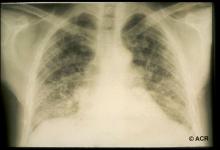Biologic Safety Holds Up in RA Save

An updated systematic literature review has provided reassuring evidence regarding the increasing safety of biologic disease-modifying anti-rheumatic drugs (DMARDs) in the treatment of rheumatoid arthritis (RA), European researchers reported.
In 15 studies, including those informing a previous literature review in 2013, the risk of serious infections continued to be elevated among patients on biologic DMARDs compared with those on conventional synthetic DMARDs, with adjusted hazard ratios ranging from 1.1 to 1.8, according to Sofia Ramiro, MD, PhD, of Leiden University Medical Center in the Netherlands, and colleagues.
However, among the most recent studies -- which had a low risk of bias -- there was no increase in the risk for serious infections. "This effect may reflect a change in the attitude of physicians who now more carefully screen and monitor patients (including infection prophylaxis, when indicated) and treat infections in patients on biologic DMARDs appropriately," the researchers wrote online in Annals of the Rheumatic Diseases.
The European League Against Rheumatism recently updated their recommendations for RA treatment. Experience thus far, as reflected in those recommendations, has not shown any important differences in efficacy between the biologics and also the newer targeted synthetic DMARDs such as the Jak inhibitors, so safety differences may help in treatment choices. "While short-term safety is addressed in clinical trials, it is long-term safety that we are primary interested in when making our decisions," Ramiro and colleagues explained.
Therefore, to provide an updated review of the safety of available RA DMARD treatments, the team undertook a systematic literature review of studies published through March 2016, identifying a total of 26 studies.
All of the studies included patients receiving biologics, but none addressed the newer targeted synthetic DMARDs or glucocorticoids.
Risks of infection were addressed in 15 studies. In one that compared the risks for serious infection in patients on biologics with the general population, the adjusted hazard ratios were 16 to 20 for the tumor necrosis factor (TNF) inhibitors.
Six studies looked at the occurrence of herpes zoster, and found no increased risk for patients on TNF inhibitors, particularly in the studies with a low risk of bias and with adjustment for treatment withdrawals. None of the studies included other types of biologics.
Seven studies, most of which had at least moderate risk of bias, considered the risk for tuberculosis. These studies identified an increased risk among patients on TNF inhibitors compared with the general population and with patients on conventional DMARDs, with adjusted hazard ratios ranging from 2.7 to 12.5.
In studies that compared the risks for serious infections among the various biologics, one study found a higher risk with infliximab (Remicade) than for etanercept (Enbrel), and another found higher risks for infliximab, etanercept, and rituximab (Rituxan) than for abatacept (Orencia).
Risks of malignancies were evaluated in nine studies, with six being at low risk of bias. Compared with patients on conventional DMARDs and with the general population, patients on biologics had no overall increased cancer risk or risk for individual solid cancers. However, compared with the general population, patients on TNF inhibitors had a higher risk of lymphoma, with adjusted hazard ratios of 2.3 to 5.9. Compared with patients on conventional DMARDs, there was no increased risk for lymphoma among those on biologics.
Nonmelanoma skin cancer occurred more often in patients on biologics compared with the general population, with an adjusted hazard ratio of 1.7, but there was no increase in comparison with patients on conventional DMARDs. In addition, one study suggested that patients on biologics may be at elevated risk for melanoma compared with those on conventional DMARDs, with an adjusted hazard ratio of 1.5.
Otherwise, there were no new safety signals identified.
"In general, our conclusions are in line with those drawn in 2013, which is reassuring. The accumulating body of evidence related to biologic DMARDs is consistently showing us that patients with RA can be treated in a relatively safe way with these drugs," Ramiro and colleagues wrote.
They noted that observational studies evaluating the risks among patients with targeted synthetic DMARDs have not yet been reported, but that data from the initial randomized controlled trials suggested that there may be a risk of serious infections with some of these agents, as well as for herpes zoster and tuberculosis -- "risks that should not be ignored and that warrant further research."
Further work is also needed to clarify the risks for infections, cardiovascular disease, and mortality among patients receiving glucocorticoids.
The authors said that future updates of the report will be needed as more safety registry data become available, such as a recent study (accepted for publication after this systematic literature review was done) that identified a higher risk of lower intestinal perforation in patients being treated with tocilizumab (Actemra) compared with those on conventional DMARDs.







If you are a health practitioner, you may Login/Register to comment.
Due to the nature of these comment forums, only health practitioners are allowed to comment at this time.